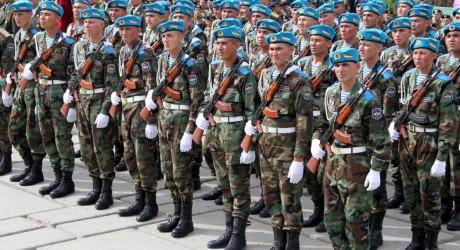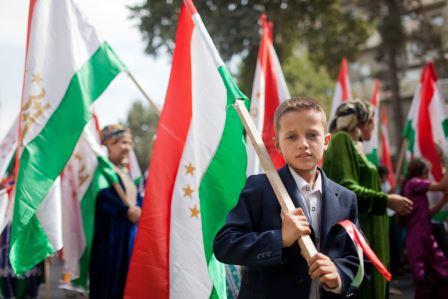
| HOME | HISTORY | PEOPLE | CULTURE | CITIES | GALLERY | AUTHORS |
Tajikistan is a mountainous country. Muffled with a thick snow layer during the winter time, the foothill mountains keep their snow-white cover for a long time, and only the first rays of spring sun are able to melt it, exposing... a small miracle: tiny lilac heads of snowdrops on thin stemlets. From time immemorial, this incontestable proof of coming of a long-awaited spring was a cause for great festival among the Tajiks.
The first among the children, who found snowdrops (''boychechak in Tajik) germinated from the snow, is considered lucky. Following him the rest rural small fry ran to the mountains to pick up snowdrops and give them to their mothers, sisters, neighbors, and teachers - all the village women as a symbol of a resurgent life, youth and beauty. The women put the flowers to the eyes and give thanks to God that they lived to see the spring and treat the children with sweets, baked goods and fruits... This tradition is called "guldardoni" by the Tajiks. Then every family cooks traditional pilau which is also called as "Oshi Boychechak". All the kinsfolk and friends gather for the treat. This festivity is a preparation for the main spring holiday - Navruz.
The spring snowdrops are followed by tulip flowering. It falls on summer season when the mountains have been already covered with a carpet of emerald greens on which red, yellow, pink tulip flower-buds, as though embroidered with a skilful hand, are blossoming...
This is such an impressive eyeful that a whole festival is devoted to this event. The Tajiks call it Sayri lola. It coincides with the time of first harvesting which means that the richer crop the more pompous festive tableful. By tradition the centre of the table is graced with a dish of pilau, women also bake brown griddle-cakes and spiced samsa, the table is served with ripe vegetables and fruits.
The Tajiks expect not only tasty food on Sayri Lola festival but also the "gushtingiri", the contests in Tajik national fight arranged by tradition on this day In former times this contest was the main and hot-tempered entertainment of the year. And today "gushtingiri" is rival in beauty and staginess to modern sports and gathers a great number of fans and fellows coming to Tajikistan even from abroad.
This is one of the most honorable religious holidays for all Muslims celebrated 70 days after the Ramadan month when all the believers observe strict fastening. There is a legend about the roots of this
holiday in the Holy Scripture. It says that Allah did not allow faithful Muslim by name Ibrahim to sacrifice his son Ismail, by putting a ram on the Sacrificial Altar. Since that it is customary to sacrifice animals as a symbol of credo of God's omnipotence and bowels of mercies.
On Idi Kurbon the believers wear clean braws, go to mosques, slaughter a sacrificial lamb or calf, give out the meat to the poor - a part of the meat is given to poor relatives and the rest part is used to cook festive meals. This day it is customary to visit friends and relatives and receive guests.


Celebration of Navruz in Tajikistan is an incredible eyeful in its beauty.
On these festive days spring comes entirely to the ancient Tajik land and it may be finally seen in its fine
splendor. The caressing sun cherishes the mountain peaks and lucid snowdrops fight their way through slobber. These first spring florets are the main harbingers of the festival. Traditionally, village children give them out as a symbol of the beginning of spring.
Tajikistan prepares for Navruz in advance, first of all, spiritually: by paying debts and forgiving old insults. This day of the holiday, people put on clean clothing, symbolizing a complete expurgation. Rituals with fire dating back to Zoroastrian roots of the holiday are obligatory this day. All household should come round a bonfire or torch alight in sign of good hope against the best.
By lunch time, hosts invite guests to festive table, served with the dishes traditional for Navruz holiday: sumanak (concoction from wheat sprouts), sambusa (sausage roll from puff-paste or rissole with greens), sabzi (vegetables) and so on. All in all, there should be seven ritual dishes beginning with "S".
Navruz is widely celebrated both in cities and villages. This day everybody goes to the main square to watch festive shows participated with singers, dancers and musicians. It is impossible to imagine the celebration of Navruz in villages without horserace, national sports contests, cockfighting, flying the kites and pigeons, and traditional goat snatching (buzkhkasi).
Tajikistan celebrates Mother's Day on 8 March. "Our people posses an ancient culture of woman veneration", the Tajiks themselves say, Once, in our country, there existed a spring holiday devoted to the cult of women. Today when our original traditions are reviving we consider this holiday as a continuation of the ancient cult.
Not only women but also men like this day. It cannot but to get into spirit of this fine day when the nature is flourishing and the beauty of our dear and darling women are flourishing even brighter. For them, this day means flowers and presents, tableful, cordial words and gallant acts. In Tajikistan, 8 March is an ancient festivity in modern way.
Perhaps, New Year in Tajikistan became a favorite, long-awaited and magic holiday as before, only the last few years. The country, which did not yet fully recover from the consequences of the civil war, has been devoid of all New Year joys for a long time. Today the situation is changing for the better: the holiday comes to cities, villages and every house... The cities' streets are decorated with garlands, flashlights and other tinsels.
Behind the windows of the houses one can see shadow-figures of New Year Trees and the courtyards smell with tasty flavor... The metropolitan authorities make every effort for the citizens to celebrate this holiday lively and memorably. The Dushanbe parks host festive events. And the metropolitan square "Dusti" where the largest New Year tree is installed became the place to hold a grandiose fair in day time and in the evening, to hold a festive concert with participation of Tajik pop stars, crowned with majestic fireworks.

9 May is the date when people's memory comes back again to those old and tragic events of the war period. It is impossible to remember them without tears of bitterness and happiness and only with thanks for the feats of arms and everybody's self-abnegation, and those who did not come from the war. The Day of 9May is sacred for the Tajik people who lost over 300,000 soldiers in the Great Patronymic War. Every year, the President himself congratulates the war veterans at a solemn event held in Victory Park. Laying of wreath to the Quenchless Flame also takes place there. These days the war veterans are honored throughout the whole republic. All the military units, parks, squares host traditional meetings with the war veterans, concerts and tablefuls.

This day is certainly one of the main holidays for all Tajik residents who survived the Civil War of 1993-1998. It commemorated the end of five-year horror which killed over 100,000 people and made millions of aboriginal inhabitants become refugees. .
In 1998 Emomali Rakhmon, the President of Tajikistan signed a decree establishing 27 March as National Reconciliation Day and announcing it as a day-off. Festive events and actions take place throughout the country on this day.

The celebration on occasion of Tajik Independence Day takes place in "Kokhi Borbad" State Complex. The festive concert program includes performances of the best creative teams of the republic and famous pop and theatre artists. This day, public open-air merrymaking is held in every place: in "Ayni" Park, "Friendship of Peoples" Park, at "800-Anniversary of Moscow" Square and metropolitan Amphitheater.
